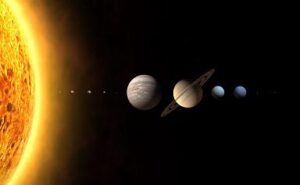God of our fathers, Whose almighty hand
Leads forth in beauty all the starry band
Of shining worlds in splendor through the skies
Our grateful songs before Thy throne arise.
There’s an old joke about a comedians convention at which those in attendance didn’t bother to tell any jokes in their speeches, but rather referred to the jokes by number so everyone could think of the joke and laugh, and the speaker could get on with his speech. In much the same way, people who discuss philosophy and theology have given labels to a handful of ideas which attempt to prove that God exists. One of those, the one in which we are interested at the moment, is called the teleological argument for the existence of God. It’s an argument you’ve surely heard, but might not know by that name. Teleology is about design.
In the classic formation of the argument presented by William Paley in his Evidences of the Christian Religion, it is predicated that the existence of a watch demands the existence of a watchmaker. From this it is then argued that the universe has the marks of a designer, the act of an intelligence who or which put it all together. Hence there must be a god (not necessarily the Christian God, but at least a creative intelligence) responsible for the construction of the world.

The argument often appears in surprising contexts. Just recently, world famous atheist Antony Flew became a deist at 81 years old because of the complexity of DNA. He stated that he did not see proof of the God of Christianity, but that after all these decades of being absolutely certain there was no evidence of the existence of any deity at all, he suddenly realized that the basic building blocks of life contained a complexity which could not have happened by any combination of chance and the known laws of science. Life must have been designed, as it could not merely have happened.
The words of the hymn which opened this column, written by Daniel C. Roberts in 1876 to celebrate the American centennial, reflect the notion that the night sky demonstrates God’s creative work. Paul’s Epistle to the Romans tells us in the middle of the first chapter that God is revealed through His creation, such that all men know something about Him from what He has made. Paley’s watch argument was primarily looking at the sky, at the movements of planets and stars and other objects in space. It may be that the structure of the universe on this grand scale has a complexity that demands a designer, just as the microstructures within living cells were compelling enough to move a confirmed atheist to a belief in God.

The problem with teleology at this grand scale is that men are very good at finding explanations for the order that appears around us. Sir Isaac Newton lived in a time when it was thought that angels carried the planets around the sun. He created the formulae which explained momentum, and in concluding his work decreed that he had moved the angels from their task of pushing the planets to a new task of holding them in their orbits. By now we have dispensed with the angels entirely, as we have a complete explanation of how planets are kept in their orbits. We then confuse how it works with whether it was indeed designed to work that way, and professing to be wise we become fools, deciding that because we understand how it works we no longer need God. We desperately attempt to push structure back to something that happened entirely by chance, turning design into accident, to escape the demand that the Designer must exist. Empiricist philosopher David Hume answered Paley by asserting that in an infinite universe even watches would somewhere happen entirely by chance, that explosions in print shops will produce complete dictionaries if we have enough of them. Roll the decillion-sided dice enough times and they will come up snake eyes eventually.
Yet as Christians we know that He does exist. There may be explanations for how it all works. One day it may be that even the complexity of DNA will be explained in a fashion that makes it possible to pretend such a thing might merely have happened. That we can see the structure of the design does not eliminate the fact of design. Some would say it only makes the design more wondrous.
Last month I raised the question of how the heavens can tell the glory of God in a modern or futuristic game. One answer may lie here: the complexity of the structure of creation is such that a designer more intelligent than any of us is necessary.
Of course, our hand-crafted universes have designers; we design them. Thus there is a dodge, a way to sidestep the teleological argument within the game world. Don’t push it, because it can’t be pushed too far.
On the other hand, having characters marvel at the wondrous structure of the imaginary universe and recognizing the hand of the designer behind the design may be a way to spark thought about whether the design of the real world similarly requires such a mind creatively at work.
This article was originally published in February 2005 on the Christian Gamers Guild’s website. The entire series remains available at its original URL.
